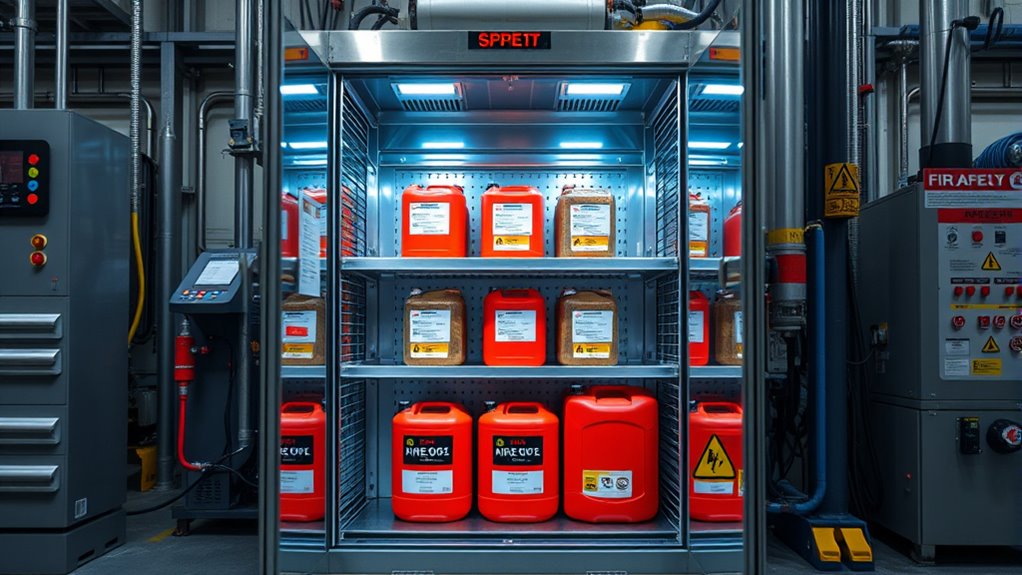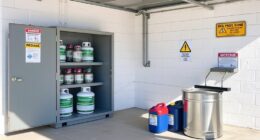To safely store fuel and minimize fire risks, use approved, clearly labeled containers designed for flammable liquids, filling them in well-ventilated areas away from ignition sources. Keep fuels in cool, dry spots like garages or sheds, on stable surfaces, and ensure lids are tightly sealed. Maintain fire alarms nearby, limit access, and avoid overstocking. By following proper procedures, you reduce hazards—continue exploring more safety tips to protect yourself and your environment.
Key Takeaways
- Use approved, clearly labeled containers designed for flammable liquids to prevent leaks and vapor escape.
- Store fuels in cool, dry, well-ventilated areas away from heat, sunlight, and living spaces.
- Keep containers tightly sealed, on stable surfaces, and regularly inspect for leaks or damage.
- Limit access to trained personnel, post warning signs, and keep fire extinguishers nearby.
- Fill containers in well-ventilated areas, avoid overfilling, and handle fuels carefully to prevent spills and accidents.

Have you ever wondered what truly fuels the flames that ignite passion, innovation, or even destruction? The answer often lies in the fuels we store—substances like gasoline, kerosene, or other combustible liquids. While these materials can power our projects, heat our homes, or provide energy in emergencies, they also pose serious risks if not stored properly. Ensuring safety isn’t just about keeping fuels away from open flames; it’s about understanding how to store them correctly, minimize hazards, and prevent accidents.
First, always choose the right containers for your fuels. Use approved, clearly labeled containers designed specifically for storing flammable liquids. These containers are engineered to resist leaks, prevent vapors from escaping, and reduce the risk of spills. Never repurpose containers that weren’t intended for fuel storage, such as empty soda bottles or milk jugs—they might look similar but lack the necessary safety features. When filling containers, do so in well-ventilated areas away from sources of ignition, and avoid overfilling. Leave some space at the top to accommodate expansion and prevent spills if the container tips.
Always use approved, labeled containers designed for storing flammable liquids safely.
Location is equally critical. Store fuels in cool, dry places away from direct sunlight, heat sources, or electrical equipment that might spark. Basements, garages, or sheds are common storage spots, but ensure these areas are well-ventilated and equipped with fire extinguishers rated for flammable liquids nearby. Never store fuels inside your living space or in areas prone to flooding. Keep containers on stable, non-flammable surfaces to prevent accidental tipping, and always close lids tightly after use to prevent vapors from escaping. Proper storage practices can significantly reduce the risk of accidents and fires.
Additionally, safeguard your storage area with proper safety measures. Install fire alarms and keep them in working order. Post clear warning signs indicating the presence of flammable materials. Limit access to trained individuals, and avoid smoking or creating sparks near storage zones. Regularly check containers for leaks, corrosion, or damage, and replace any compromised containers immediately. Proper inventory management helps you track your supplies and avoid overstocking, which increases risk.
Frequently Asked Questions
What Are the Best Types of Containers for Fuel Storage?
You should use approved, tightly sealed containers made of high-density polyethylene or metal for fuel storage. These containers are designed to prevent leaks and resist corrosion. Always choose containers labeled specifically for fuels like gasoline or kerosene, and guarantee they have a secure venting system. Avoid using makeshift or damaged containers, as they pose safety risks. Properly labeling your containers helps prevent accidental misuse or spills.
How Long Can Fuel Be Safely Stored Without Degradation?
You can typically store fuel safely for about 3 to 6 months if kept in a proper, airtight container in a cool, dry place. Over time, fuel degrades, losing potency and potentially becoming hazardous. To extend its shelf life, consider using fuel stabilizers, which can help keep it good for up to 12 months. Always check for signs of contamination or separation before use.
Are There Specific Safety Regulations for Storing Different Fuels?
Like a delicate dance, each fuel has its own safety rhythm. You need to follow specific regulations for storing fuels like gasoline, diesel, or kerosene, as they each carry unique risks. Always keep flammable fuels in approved containers, store them in well-ventilated areas away from heat sources, and adhere to local safety codes. Proper storage safeguards your environment and prevents dangerous mishaps.
How Should Spills or Leaks During Storage Be Handled?
If you notice spills or leaks during storage, you should act quickly to contain and clean them. First, wear protective gear like gloves and goggles. Use absorbent materials such as sand, kitty litter, or commercial spill pads to soak up the fuel. Avoid open flames or sparks nearby. Properly dispose of the contaminated materials according to local hazardous waste regulations. Ventilate the area and inspect for further leaks before resuming storage.
Can Fuel Storage Areas Be Safely Located Indoors?
You can safely locate fuel storage areas indoors if you follow strict safety measures. Imagine a well-ventilated, fire-resistant room with proper containment and clear labeling. You should keep the area away from heat sources, sparks, and open flames. Regularly inspect for leaks or spills, and ensure fire extinguishers are accessible. Proper storage reduces risks, making indoor placement safe when all precautions are in place.
Conclusion
By storing fuel and flames safely, you’re not just avoiding accidents—you’re preventing chaos on a scale that could rival a wildfire or an explosion of epic proportions. Think of your home as a fortress, impervious to fiery disasters. When you follow these simple safety steps, you’re not just protecting possessions; you’re safeguarding your entire world from destruction. Remember, a tiny mistake with fuel can spiral into a catastrophe that changes everything—so always stay vigilant and cautious.










